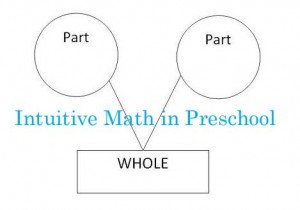 This post is the third in a series on encouraging intuitive math skills in preschool children. If you would like to see the first post (Number Awareness and Recognition, 1-to-1 Correspondence, and Subitizing), you can view it here. Activities for 5 and 10 Frames can be printed here.
This post is the third in a series on encouraging intuitive math skills in preschool children. If you would like to see the first post (Number Awareness and Recognition, 1-to-1 Correspondence, and Subitizing), you can view it here. Activities for 5 and 10 Frames can be printed here.
There are 6 important number concepts that preschoolers need to have opportunities to explore through play in order to develop good math intuition skills. This numbers post (Part Three} will concentrate on playing and learning with the concept of: Part Part Whole.
6 Important Number Concepts for Preschool
Number Awareness and Recognition
One-to-One Correspondence
Subitizing
Anchors of 5 and 10
Part+Part=Whole
More Than, Less Than, or Equal To
PART PART WHOLE MATH in PRESCHOOL
When young children have had many opportunities to play with 5 and 10 Frames and can visualize (through subitizing) small groups of numbers, we can begin to offer opportunities to play with and explore the concept of Part Part Whole.
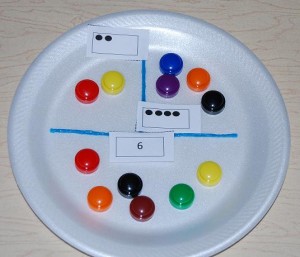 COMPOSING NUMBERS – NUMBER BONDS – Number Bonds
COMPOSING NUMBERS – NUMBER BONDS – Number Bonds
Number bonds are the relationships between any number and the parts that make that number. The basic concept of a whole number being made up by parts is central to addition; if children can see the parts, then they can add the parts together to make the whole. Similarly, by taking away (subtracting) one of the parts from the whole, the children can find the missing part.
Materials needed: One number bond printable for each child, a paper plate divided into three sections (two on the top as indicated in the photo above (PARTS) and one section on the bottom), and small manipulatives if desired (suggestions: Unifix cubes, Legos, buttons, pony beads, small shells, etc.).
Prior to the activity: Print the number bond cards and laminate for durability (clear contact paper will work if laminating supplies are not available). Cut each of the cards apart.
The number bond cards above work with visualizations of the number parts (1-5) in order to form the numbers 1-10. Invite your children to randomly pick two of the dot cards and place them inside the two boxes at the top of the paper plate. When added together, those two parts will make up a whole. Have the children add the dots (through subitizing or counting with manipulatives) to find what number card should be placed in the bottom section of the paper plate (WHOLE).
As children gain confidence in adding the parts to find the sum, we can help children understand the inverse relationship between addition and subtraction by placing one number card in the WHOLE section of the paper plate and just one dot card in the PARTS section of the paper plate. The children must then find the missing PART (dot card) to complete the number bond.
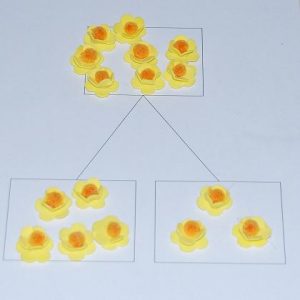 *Note – the blank Part Part Whole Template can also be used with manipulatives (or the children can write or use number stamps) to complete the worksheet. – Part Part Whole Blank Template
*Note – the blank Part Part Whole Template can also be used with manipulatives (or the children can write or use number stamps) to complete the worksheet. – Part Part Whole Blank Template
DECOMPOSING NUMBERS INTO PART PART WHOLE
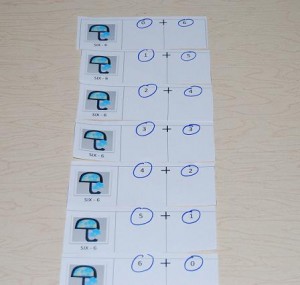
When decomposing numbers into the separate parts, there is a pattern. Making vertical number lines will help your children visualize the pattern. Our 4 yr. olds could see the pattern and found the same pattern works to decompose any number into parts. Cut apart the individual cards (numbers 1-10 linked below) and place them in sequential order on a table or the floor. In the photo above, our kids were working with the Number Six Printable.
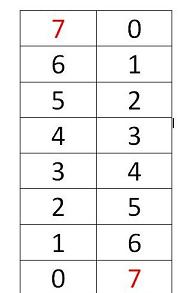
The number cards for decomposing #’s 1-10 are linked individually below. For younger children, begin with the smaller numbers until the children can recognize the parts that make up each number before working with larger numbers.
Decomposing One
Decomposing Two
Decomposing Three
Decomposing Four
Decomposing Five
Decomposing Six
Decomposing Seven
Decomposing Eight
Decomposing Nine
Decomposing Ten
We hope your children enjoy playing with Part Part Whole Math in Preschool. To continue this math series, please see Intuitive Math: Part 4: games for greater than, less than, or equal to. To make sure you don’t miss any future posts, please take a moment to subscribe to our blog!